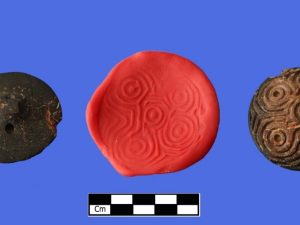Tol-e Khariتل خاری
Location: Tol-e Khāri is an archaeological site in the Plain of Morghāb, Pasargadae, in southern Iran, the Province of Fārs.
30°13’08.0″N 53°10’16.1″E
Map
Historical Period
Neolithic, Bronze Age, Elamite, Achaemenid, Islamic
History and description
Tol-e Khāri is a large archaeological site, covering approximately 3 hectares (fig. 1). It is located 500 m north of the Abolvardi village, in the Plain of Mōrghāb, at Pasargadae. The site originally consisted of five distinct mounds (numbered 1 to 5, of which only three have survived. Extensive agricultural activities destroyed a large part of the site. Mound 1 yielded Neolithic remains while the other two mounds include vestiges of the Achaemenid to Islamic periods.
Mound 1 measures approximately 110×55 m with a height of 2 m above the surrounding plain. It is roughly oval in shape. Excavations at Mound 1 revealed nine occupational phases from the late fifth millennium B.C to the Post-Achaemenid period. Four Phases 9, 8, 7, and 6 belong to late Bakun or Bakun A (late fifth millennium B.C.), and phases 5 and 4 to Lapui periods (early fourth millennium B.C). The site was reoccupied in the Achaemenid period, in phases 3 and 2, when the excavations yielded iron slag pits and fill. Such finds show that perhaps Tol-e Khari was a workshop for the production of iron objects and building materials in the Achaemenid period. Phase 1 is the topmost level and contains scattered finds that might be dated to the Post-Achaemenid period.
Archaeological Exploration
Ali Sami, the then Director of the Scientific Institute of Persepolis and Pasargadae, explored Tol-e Khāri (Mound 1) in the 1950s on behalf of the Iranian Department of Archaeology. Alireza Sardari excavated Tol-e Khari on behalf of the Iranian Center for Archaeological Research in 2017 and 2018.
Finds
Pottery: Charectersitic pottery of the Bakun period with black on buff sheds that are elaborately decorated with geometric and animal motifs.
Other finds: Figurines, seals, sealings (fig. 2), bone objects, spindle whorls, beads, tokens, stone objects, grinding stones, shell objects, worked sherds, pierced sherds, pieces of obsidian, as well as a large number of animal bones and faunal remains.
Bibliography
Agha-Aligol, D., F. Farshi Jalali, A. Sardari, and M. Moradi, “Elemental Composition and Statistical Analysis of Obsidians from Tole Khari in Pasargad Complex Using Micro-PIXE Technique,” Journal of Research on Archaeometry, No. 7/2, 2021, pp. 91-109.
Author: Alireza Sardari
Originally published: July 23, 2022
Last updated: September 19, 2024



































































































































